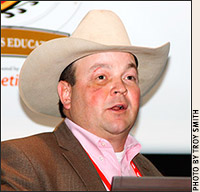Ranchers Talk About Managing High-risk Calves
Cattlemen offer presentation addressing management of calves.
SAN DIEGO, Calif. (Jan. 29, 2016) — If calves become sick, they require timely treatment with an appropriate remedy. But giving medicine to sick calves is a chore that Washington cattleman Tyler Cox tries to avoid. Speaking to fellow beef producers attending the 2016 Cattle Industry Convention in San Diego, Calif., Cox said, “My goal is to not need antibiotics.”
 “Whether it’s related to health or anything else, risk management should focus on controlling the variables,” Ira Brackett told Cattlemen's College attendees.
“Whether it’s related to health or anything else, risk management should focus on controlling the variables,” Ira Brackett told Cattlemen's College attendees.
During Wednesday's Cattlemen's College®, Cox and California rancher Ira Bracket offered a tag-team presentation addressing management of calves that might be considered at high risk for health problems. Along with cow herds, both ranchers manage yearling enterprises that include purchased calves, and both ranchers try to avoid buying other peoples’ problems. They prefer to source calves directly from the animals’ ranch of origin, buying at private treaty or through video auctions. They prefer to buy calves from sellers that manage cattle health through preventive measures.
“Whether it’s related to health or anything else, risk management should focus on controlling the variables,” stated Brackett. “So my purchase preference is for weaned and preconditioned calves — calves that have been managed much the same way we do it ourselves.”
Brackett buys some unweaned calves, but they must have been subjected to a good vaccination program and managed with attention to Beef Quality Assurance (BQA). His own employees have received training and are BQA-certified. Brackett also stressed the importance of acclimating cattle to their surroundings and handling methods. He insists that his crew consistently use effective cattle-handling techniques. When working cattle, employees are assigned to tasks for which they are best suited.
 “You can tell, from the calves, which producers are screamers and which ones practice low-stress handling,” Tyler Cox shared.
“You can tell, from the calves, which producers are screamers and which ones practice low-stress handling,” Tyler Cox shared.
“I want the best people for the job, whether it’s bringing cattle to the chute or giving shots,” explained Brackett, “They all need to do their jobs as if it were being shown on a video.”
Cox emphasized how low-stress cattle handling aids cattle health management. He noted how the manner in which purchased cattle were previously handled soon becomes evident. It shows in their behavior, health and performance.
“You can tell, from the calves, which producers are screamers and which ones practice low-stress handling,” grinned Cox, admitting that the women on his family’s outfit display infinitely more patience and willingness to change and adapt to different techniques. He challenged fellow males to swallow their pride and commit themselves to better cattle-handling practices.
Cox also emphasized calf nutrition and the important roles minerals and vitamins play in optimizing calf immune function. He called parasite control another important step to enhancing calf response to vaccination against disease and optimal health status. Specific to newly arrived, stressed cattle, Cox grants them some recovery time before processing. He lets calves “chill out” for two or three days before administering vaccine and dewormer. He also delays branding and tagging of high-risk cattle until their second trip through the chute.
Cox challenged the producer audience to “get some religion.” He advised them to take a disciplined approach, practice BQA every day, and avoid treating sick calves by trying to keep them from getting sick in the first place.
Editor’s Note: The articles used within this site represent a mixture of copyrights. This article was written by or under contract of the Angus Journal, an Angus Media publication. If you would like to reprint or repost the article, you must first request permission by contacting the editor at 816-383-5270; 3201 Frederick Ave., Saint Joseph, MO 64506. The Angus Journal claims copyright to this website as presented. We welcome educational venues and cattlemen to link to this site as a service to their audience.

